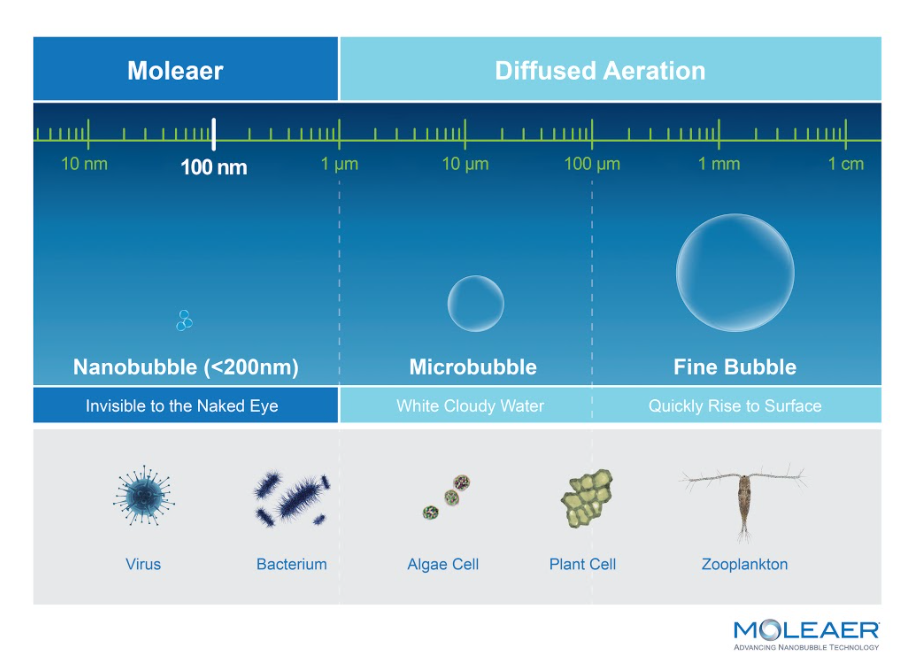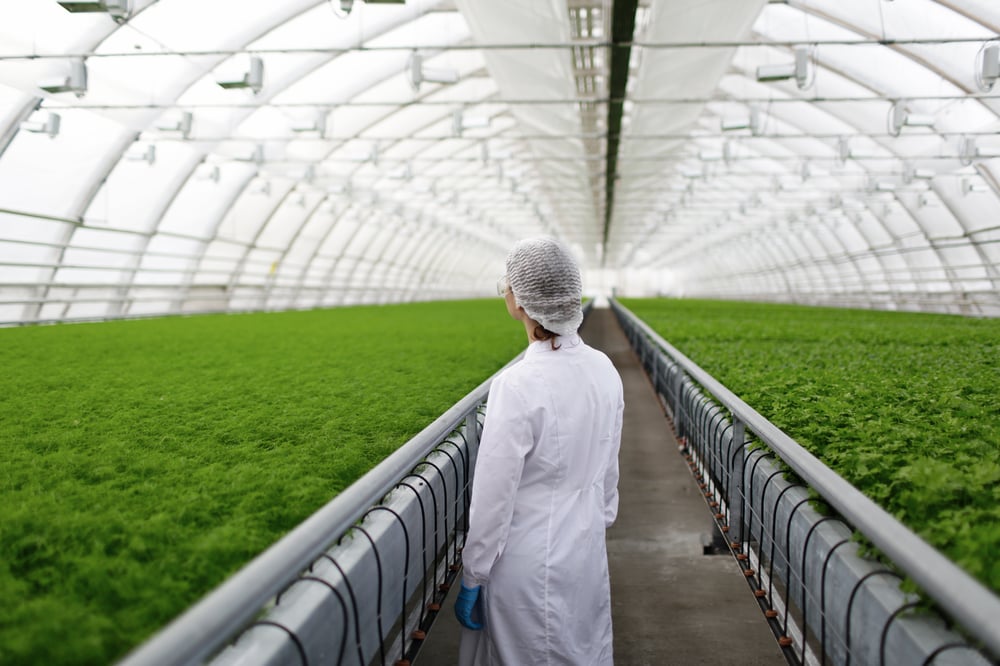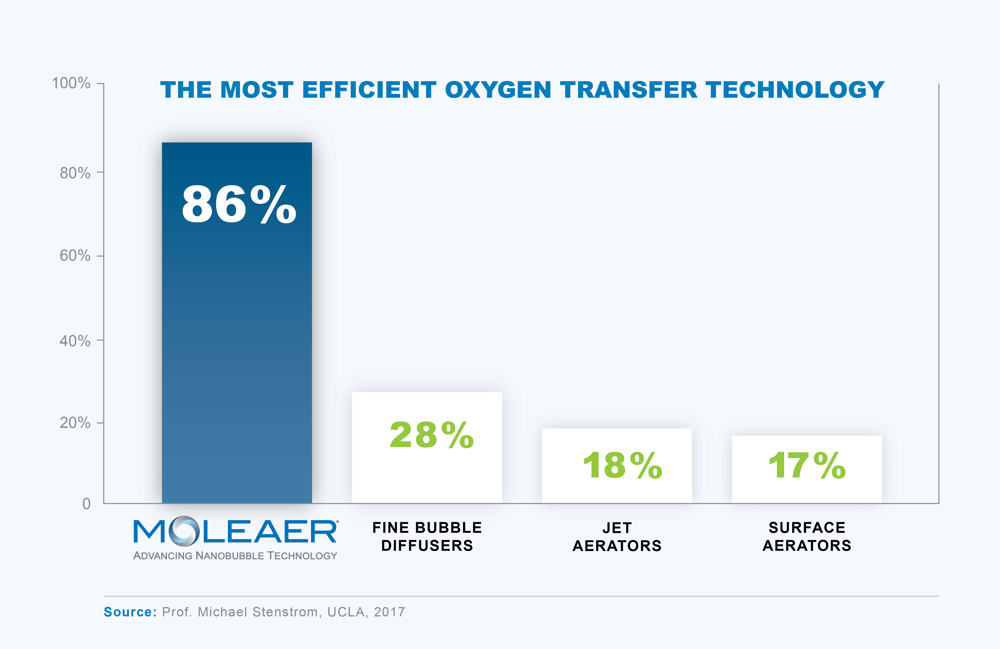Nanobubbles are 70-120 nanometers in size, 2500 times smaller than a single grain of salt. They can be formed using any gas and injected into any liquid. Due to their size, nanobubbles exhibit unique properties that improve numerous physical, chemical, and biological processes.
Conventional aeration technologies achieve less than 3% oxygen transfer efficiency at standard conditions (SOTE) per foot of water. Third-party testing confirms that Moleaer’s nanobubble technology achieves >85% SOTE in just 2 feet of water, enabling dissolved oxygen (DO) levels to increase while using far less oxygen than any other aeration technology.
Nanobubbles are superior to all other scalable gas transfer methods because they:
Contaminated water is a growing concern for human, plant and animal health. Nanobubbles offer a chemical-free solution to degrade water contaminants by accelerating and enhancing known degradation and oxidation processes.
By introducing oxygen nanobubbles which release oxygen when they burst or react, Moleaer’s technology helps promote aerobic degradation by aerobic bacteria, a naturally occurring process in the subsurface environment. Nanobubbles also enhance the performance of Ultraviolet Light (UV) contaminant degradation.
Another common way to treat water is through oxidation, but it is often achieved using undesirable or harsh chemicals to disinfect water and remove contaminants. Moleaer’s technology enhances oxidation without these chemicals, enabling customers to apply more ozone, a known oxidizing gas, with greater transfer efficiency and helping reduce the reliance on oxidizing chemicals.
Moleaer’s nanobubble technology provides a chemical-free means of improving water quality. Nanobubble degradation and oxidation can be used to:
Nanobubbles naturally adhere to suspended, colloidal, and emulsified materials, causing them to clump together so they can be easily removed from water by filtration or flotation. When added to Dissolved Air Flotation (DAF) processes, nanobubbles can improve solids removal while using up to 90% less energy than air saturators.
Nanobubbles have been used across various physical separation processes to remove:
Nanobubbles effectively prevent and remove unwanted buildup in wet environments. They scour surfaces in food washing, drip lines, swimming pools, and irrigation pipes, reducing the need for harsh chemicals that can damage pipes and filtration systems.
Nanobubbles are proven effective at:

Nanobubbles behave differently from larger bubbles because they’re nanoscopic. All of their beneficial attributes — stability, surface charge, neutral buoyancy, oxidation, etc. — are the result of their size. These unique features enable nanobubbles to participate in physical, biological, and chemical reactions while also providing the most efficient gas transfer.
Nanobubbles have created a new frontier of science and engineering that is changing how entire industries utilize and treat their water. Moleaer’s technology and fundamental understanding of nanobubbles is continuously evolving with recent advancements in nanobubble production methods and ongoing discoveries around how to measure, manipulate, and apply nanobubble properties to solve customer problems.
Customers around the world trust Moleaer’s technology for its efficacy, reliability, and proven results. With over 1500 nanobubble systems in use, Moleaer’s technology treats more than 560 million gallons of water daily in everything from oil fields to greenhouses to reservoirs and fish hatcheries. These industry-leading qualities come from Moleaer’s commitment to constant progress: our engineering team conducts extensive laboratory and field research to continuously identify the beneficial properties of nanobubbles and validate the value they deliver to our customers.

Our efforts to advance the science of nanobubbles and push the industry are supported by an array of partners, including acclaimed universities and research institutes. This ensures our products are tested by third-party experts to validate the efficacy of nanobubbles: UCLA professor and aeration expert Michael Stenstrom reports, "Moleaer's nanobubble generators provide the highest oxygen transfer efficiency of any aeration technology I have tested." ASU confirmed the oxidative properties of Moleaer nanobubbles and the formation of hydroxyl radicals in their study. Virginia Tech proved that Moleaer’s nanobubbles eliminate pathogens like E. Coli and Listeria on surfaces within five minutes of exposure. Further, the size and concentration of Moleaer’s nanobubbles have been validated by multiple independent researchers using Nanoparticle Tracking Analysis (NTA) — full NanoSight report here.
.png?length=1000&name=Moleaer_Nanobubble_Motion_Graphic_Final%20(1).png)
Nanobubbles are generally classified as being less than 200 nanometers (nm) in diameter. Moleaer’s patented nanobubble generation method is the only scalable method in the industry that consistently produces high density solutions of optimally sized nanobubbles, averaging 100 nm in diameter and ranging between 70 and 120 nm. Nanobubbles of this size are stable in liquid because they have reached equilibrium with bubble surface tension, internal pressure, external pressure, surface charge, and their environment. Their stability and size give them neutral buoyancy. The net effect is that, once injected, nanobubbles are ready to react - they remain suspended in solution and disperse until they interact with surfaces or contaminants.

Their unique characteristics enable nanobubbles to participate in a wide range of reactions. This, even more than efficient gas transfer, reveals the truly revolutionary potential of nanobubbles: they can replace or significantly reduce harmful chemicals and the infrastructure traditionally required to treat water. Nanobubbles can be used to improve the efficiency of a broad spectrum of chemical, biological, and physical processes. Nanobubbles remove impurities and pathogens from wet environments, making them incredibly effective at improving production and processes across many industries and applications.
Nanobubbles can also participate in reactions due to their strong negative surface charge and other force attractions. Like a magnet, nanobubbles will be attracted to and attach to fine particulates, colloids, oil droplets, other contaminants, and surfaces — in particular, nanobubbles are attracted to target substances like organics, oils, residual hydrocarbons, surfactants, grease, and fats. When enough nanobubbles attach to a tiny particle or droplet, its density decreases, enabling it to separate from the water around it so the particle can be removed by flotation or filtration.
In water treatment, chemical oxidation is typically achieved using ozone, UV, or harsh chemical treatments. Nanobubbles can achieve this same oxidative effect using only air and water. Their size gives them stability and a strong negative surface charge that increases the rate of interaction between nanobubbles and water impurities. When stimulated, nanobubbles destabilize, resulting in hydroxyl radical (OH) formation. Hydroxyl radicals are in a highly oxidative state so they rapidly destroy water contaminants by breaking apart their molecular structure.

Moleaer nanobubbles are more efficient, last longer, and are often more cost-effective than other gas transfer solutions. They have created a revolution in the field of oxygen transfer, commonly referred to as aeration or oxygenation. Since nanobubbles are neutrally buoyant, they disperse throughout a water body, delivering oxygen to the bottom of a water column (i.e., near the bottom of a lake), as well as near the surface. Nanobubbles accumulate in water to create a reserve of entrained oxygen - up to 20% greater than the gas saturation point - so DO remains stable longer. This combination of features enables Moleaer’s nanobubbles to provide highly efficient and consistent gas transfer across a broad range of water treatment processes. Moleaer’s unmatched nanobubble production rates across a wide range of liquid flow capacities makes nanobubble treatment possible for both small and large scale processes.
Nanobubbles are generated by an ultrafine bubble generator. These extremely small gas bubbles are one of the most effective methods of improving water chemistry and quality. Due to their size, nanobubbles exhibit unique properties that improve numerous physical, chemical, and biological processes.
Dissolved oxygen is a measure of how much oxygen is present within a body of water. This is important because water bodies and crops rely on a certain amount of available oxygen to thrive. Dissolved oxygen is one of several ways to assess the quality of the water. Using an ultrafine bubble generator can add more oxygen when levels are too low.
These ultra-fine bubbles also aid the following industries.
Wastewater treatment: Nanobubble technology is an innovative tool for wastewater treatment, improving treatment efficiency, reducing energy use, allowing better performance of existing aeration systems, and producing better biological oxygen demand (BOD) and chemical oxygen demand (COD).
Lakes and ponds: Nanobubbles are a sustainable tool for lake managers and owners to improve water quality and give their bodies of water a fighting chance against unwanted algae, muck, and foul odors.
Agriculture and horticulture: This technology plays a vital role in irrigation water quality for healthier, more resilient crops. Higher-quality irrigation water allows crops to absorb more nutrients and reduces the risk of diseases that lead to crop loss. Growers can maximize food production and plant growth while reducing chemical applications.
Aquaculture: Nanobubbles are highly efficient at increasing dissolved oxygen levels for healthy fish growth while lowering energy and chemical costs. In addition to increasing DO, nanobubbles suppress pathogens and reduce sea lice treatments for many farmers.
Oil and gas: Nanobubble technology is a chemical-free way to improve EOR, oil-water separation, sour water treatment, and more. As oil companies need new, sustainable ways to maintain water quality, many are turning to nanobubbles as a long-lasting solution.
Mining: Nanobubbles can also be a significant asset to mining companies. The separation method the bubbles use allows sludge and muddy water to detach from key minerals. By inserting nanobubbles deep in the excavation site, miners can also reach further into the earth than they would be able to with traditional methods.
An ultrafine bubble generator does not directly improve the water quality in a swimming pool. These machines are designed to be used for larger applications over time. As such, we do not recommend this technology for residential purposes. However, nanobubbles can treat water that may coincidentally be used in a pool later.
There are dozens of other commonly used methods for improving water quality. Many of these techniques falsely claim to offer sustainable solutions. Nanobubbles are one of the few options that truly commit to both short-term and long-term sustainability.
A Chemical-Free Tool
Nanobubbles are completely chemical-free and in many industries help to reduce the use of chemicals. For instance, in horticulture, growers can reduce their use of chemical pesticides and synthetic fertilizers after deploying nanobubble generators in their grow operations.
Additionally, wastewater treatment facilities can improve the efficiency of their processes by nanobubble surfactant removal, without having to use or increase the use of harsh chemicals that would go to aquatic systems in the effluent water. The lack of chemical treatment makes the process safer for all parties involved.
Improves Water Quality and the Environment
In addition to reducing chemical properties in specific industries, a nanobubble system can also have a profound effect on the environment. Global temperatures are rising, leading to the depletion of oxygen levels in water and a deterioration of water quality. The world’s health and industrial productivity are adversely affected by poor water quality.
Industries require sustainable solutions that enable increases in output without jeopardizing our environment. New technology solutions like nanobubble technology are paramount to providing an expanding population with food, water, and commodities necessary to support this growth.
A Moleaer ultrafine bubble generator is a necessity for any industry requiring a high-quality water supply. We provide a chemical-free, sustainable method of tackling some of the world’s most important water quality challenges. Our solutions result in over 85% gas transfer efficiency and supersaturate the water with nanobubbles.
Our company has a highly knowledgeable and skilled Research and Development team that continually researches nanobubble science and expands our technology into new applications. We sort through thousands of scientific articles and journals to find the most accurate information related to water treatment processes and do our own research using the results of those findings. Our goal is to always provide the best products in terms of efficiency, safety, sustainability, and price.
At Moleaer, we love staying up to date on new knowledge and providing our clients with the best tools to educate themselves. Here is where you can access our vast pool of information.
Visit Our Resource Center
Our resource center is a collection of data pulled from the most credible publications. We utilize the most reliable water research, including recent developments from the Journal of Colloid and Interface Science, the Separation and Purification Technology publication, and other reputable sources in various fields of environmental science and environmental engineering.
All of this information is available for free right on our website. We encourage everyone to learn about water treatment solutions for their industry to understand why Moleaer technology is the best option for various applications.
Browse Our Blog
In our blog, we cover an array of topics for industry applications of nanobubble technology to give you the science behind what we do. We transform complicated research studies into a format that most readers of any education level can understand. Learn everything you need to know from how nanobubbles suppress pathogens to how they improve soil health to how they can be utilized in your industry.
View Our Social Media
Are you looking for frequent research updates in smaller, more digestible chunks? Consider following us on social media. We post educational content on Twitter, Facebook, Pinterest, LinkedIn, and YouTube!
Do you have a question about our technology or its applications? Email one of our experts or submit a support ticket if you are having trouble with our product.